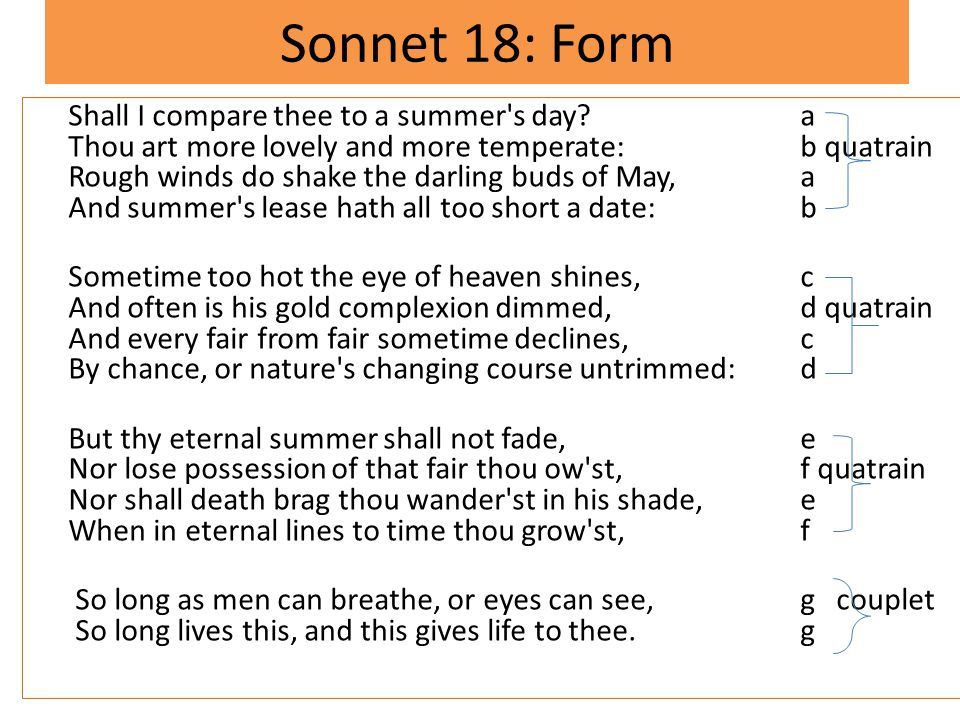Because Sonnets Aren't Enough
 Sonnet 18
Sonnet 18
Shakespearean Sonnets take up the rhyme scheme
A B A B C D C D E F E F G G
Each letter describe each similar line ending. If two lines rhyme, they are assigned the same letter.
What is the number of possible rhyme schemes a poetry with 14 lines can have?
The answer is 190899322.
This section requires Javascript.
You are seeing this because something didn't load right. We suggest you, (a) try
refreshing the page, (b) enabling javascript if it is disabled on your browser and,
finally, (c)
loading the
non-javascript version of this page
. We're sorry about the hassle.
2 solutions
Sorry if I sound stupid but I am just a beginner at discrete mathematics.
Moreover, I cant even clearly understand your solution.
My query is:
The first line has to have the corresponding letter 'A';
The second line has 2 options 'A' & 'B'
Third line has 3 options 'A', 'B' & 'C'
Continuing with the same logic the answer should be
1
4
!
What is wrong in my method?
Are there any restrictions to the rhyme scheme.
Log in to reply
Yes, there are.
A 3-line poem cannot have the rhyme scheme
AAC
. The correct way to designate this poem a rhyme scheme is
AAB
.
Log in to reply
Ofcourse, I knew this one; thats why I said that the first line must have A corresponding to it and so on.
So, where does the problen lie in
1
4
!
Log in to reply
The first line has to have the corresponding letter 'A'; The second line has 2 options 'A' & 'B' Third line has 3 options 'A', 'B' & 'C'
The third line does not always have that option. What if the first two lines are
AA
? Can the third line be
C
?
Taking the recurrence relation B n + 1 = k = 0 ∑ n ( k n ) B k is it easy to show that the generating function B ( x ) = n = 0 ∑ ∞ n ! B n x n satisfies the equations B ′ ( x ) = e x B ( x ) B ( 0 ) = 1 and hence B ( x ) = e e x − 1 From this working out the coefficient of x 1 4 is elementary, giving the answer 1 9 0 8 9 9 3 2 2 . It is also worth noting that B n = m = 1 ∑ n { n m } where { n m } is the Stirling number of the second kind, which makes the Mathematica command
1 |
|
the simplest piece of code.
Notice that the rhyme scheme is a partitioning of the lines of the poetry. So, the number of partitions of a poetry of n lines is the bell number B n .
A simple recurrence relation is B 0 = 1 and
B n + 1 = k = 0 ∑ n ( k n ) B k
This can be proven as follows. Given a set of n + 1 elements, fix an element e . Consider the partition (the equivalence class) that includes e . Suppose it contains n − k elements besides e itself. There are ( n − k n ) = ( k n ) ways to select these n − k elements, and the remaining k elements can be partitioned in B k ways by definition. Summing over all k gives the above identity.
This is the dynamic programming approach:
Let the number of equivalence relations on n elements that divide them into k equivalence classes be P(n, k).
Of course, P ( n , 1 ) = 1 and P ( n , n ) = 1 .
Otherwise, look at how this would be obtained from an equivalence relation on n-1 elements. From a relation that divides into k-1 classes, there is only one way to get one that divides into k classes (the new element must be a new class by itself). From a relation that divides into k classes, there are k ways to do this (choose the existing class the new element must become part of). It is easy to see that these are the only two cases.
So P ( n , k ) = P ( n − 1 , k − 1 ) + k P ( n − 1 , k )
Solution Inspired by Ivan Koswara and Ww Margera